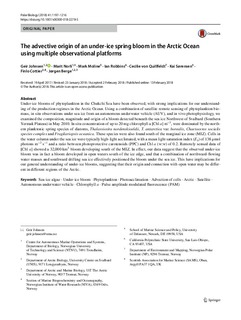| dc.contributor.author | Johnsen, Geir | |
| dc.contributor.author | Norli, Marit | |
| dc.contributor.author | Moline, Mark A. | |
| dc.contributor.author | Robbins, Ian | |
| dc.contributor.author | Quillfeldt, Cecilie von | |
| dc.contributor.author | Sørensen, Kai | |
| dc.contributor.author | Cottier, Finlo Robert | |
| dc.contributor.author | Berge, Jørgen | |
| dc.date.accessioned | 2018-12-17T11:47:29Z | |
| dc.date.available | 2018-12-17T11:47:29Z | |
| dc.date.created | 2018-03-05T08:48:29Z | |
| dc.date.issued | 2018 | |
| dc.identifier.citation | Polar Biology. 2018, 41 (6), 1197-1216. | nb_NO |
| dc.identifier.issn | 0722-4060 | |
| dc.identifier.uri | http://hdl.handle.net/11250/2577917 | |
| dc.description.abstract | Under-ice blooms of phytoplankton in the Chukchi Sea have been observed, with strong implications for our understanding of the production regimes in the Arctic Ocean. Using a combination of satellite remote sensing of phytoplankton biomass, in situ observations under sea ice from an autonomous underwater vehicle (AUV), and in vivo photophysiology, we examined the composition, magnitude and origin of a bloom detected beneath the sea ice Northwest of Svalbard (Southern Yermak Plateau) in May 2010. In situ concentration of up to 20 mg chlorophyll a [Chl a] m− 3, were dominated by the northern planktonic spring species of diatoms, Thalassiosira nordenskioeldii, T. antarctica var. borealis, Chaetoceros socialis species complex and Fragilariopsis oceanica. These species were also found south of the marginal ice zone (MIZ). Cells in the water column under the sea ice were typically high-light acclimated, with a mean light saturation index (Ek) of 138 μmol photons m− 2 s−1 and a ratio between photoprotective carotenoids (PPC) and Chl a (w:w) of 0.2. Remotely sensed data of [Chl a] showed a 32,000 km2 bloom developing south of the MIZ. In effect, our data suggest that the observed under-ice bloom was in fact a bloom developed in open waters south of the ice edge, and that a combination of northward-flowing water masses and southward drifting sea ice effectively positioned the bloom under the sea ice. This have implications for our general understanding of under-ice blooms, | nb_NO |
| dc.language.iso | eng | nb_NO |
| dc.publisher | Springer Verlag | nb_NO |
| dc.relation.uri | https://doi.org/10.1007/s00300-018-2278-5 | |
| dc.rights | Navngivelse 4.0 Internasjonal | * |
| dc.rights.uri | http://creativecommons.org/licenses/by/4.0/deed.no | * |
| dc.title | The advective origin of an under-ice spring bloom in the Arctic Ocean using multiple observational platforms | nb_NO |
| dc.type | Journal article | nb_NO |
| dc.type | Peer reviewed | nb_NO |
| dc.description.version | publishedVersion | nb_NO |
| dc.source.pagenumber | 1197-1216 | nb_NO |
| dc.source.volume | 41 | nb_NO |
| dc.source.journal | Polar Biology | nb_NO |
| dc.source.issue | 6 | nb_NO |
| dc.identifier.doi | 10.1007/s00300-018-2278-5 | |
| dc.identifier.cristin | 1570375 | |
| dc.relation.project | Norges forskningsråd: 244319 | nb_NO |
| dc.relation.project | Norges forskningsråd: 223254 | nb_NO |
| dc.description.localcode | © The Author(s) 2018 Open Access. This article is distributed under the terms of the Creative Commons Attribution 4.0 International License (http://creativecommons.org/licenses/by/4.0/) | nb_NO |
| cristin.unitcode | 194,66,10,0 | |
| cristin.unitname | Institutt for biologi | |
| cristin.ispublished | true | |
| cristin.fulltext | original | |
| cristin.qualitycode | 1 | |

